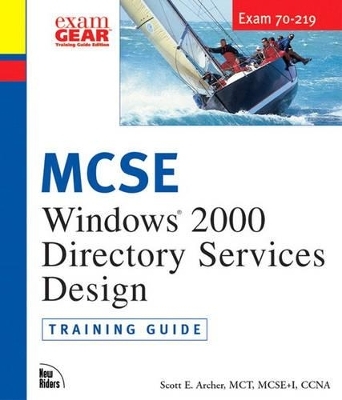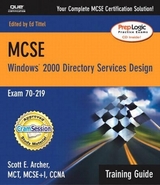
MCSE Training Guide (70-219)
New Riders Publishing
978-0-7357-0983-6 (ISBN)
- Titel erscheint in neuer Auflage
- Artikel merken
Exam 70-219, Designing Windows 2000 Directory Services Infrastructure measures your ability to analyze the business requirements and design a directory service architecture, including: unified directory services such as Active Directory and Windows NT domain; connectivity between and within systems, system components & applications, and data replication such as directory replication and data replication. Keep in mind if you already have MCSE certification on Windows NT 4.0 you can update your certification by just taking two exams-the Accelerated Exam (70-240) and their choice of Designing Directory Services Infrastructure (70-219), Designing Security for a Windows 2000 Network 970-220), or Designing Network Infrastructure (70-221). You must also choose one of the three core electives-ICA Windows 2000 Professional (70-210), ICA Windows 2000 Server (70-215), I & A Windows 2000 Network Infrastructure (70-216), I & A Windows 2000 Directory Services Infrastructure (70-217).
Scott Archer lives in Indianapolis, IN with his wife Tiffany, daughter Kira (4), and son Ethan (2). He graduated from Purdue University in 1996 with a BS in Computer and Information Science and has been in the computer business for 9 years. He is currently a Senior Consultant for FrontWAY, a national network and eBusiness consulting company where he's been working zombified recently because some book has been consuming his sleep time! Windows 2000 has been installed on his laptop since Beta 1, and has been his core focus since that time. Scott holds MCSE+Internet, MCT, and CCNA certifications and plans to continue on both Microsoft and Cisco tracks. When he is not in front of a computer, he enjoys watching and playing basketball, doing home improvement projects, trying to figure out non-computer related hobbies, and playing with the kids. If you have any non-computer related hobby ideas, please send them to sarcher@frontway.com. You can send questions or comments about the book there too!
(NOTE: All Chapters begin with Introduction.)
Introduction.
How This Book Helps You. What the Designing a Microsoft Windows 2000 Directory Services Infrastructure Exam (70-219) Covers. Hardware and Software You'll Need. Advice on Taking the Exam. New Riders Publishing.
I. ACTIVE DIRECTORY BASICS.
1. Understanding Active Directory.
“Directory” Defined. Active Directory Is a Unified Directory. Active Directory features and Benefits. Migration from Previous Versions of NT. Planning, Planning, Planning.
II. ANALYZING BUSINESS REQUIREMENTS.
2. Planning and Conducting Your Business Assessment.
Business Analysis Planning Framework. Company Categorization. What to Gain from the Analysis. Business Analysis Deliverables.
3. Analyzing the Results of the Business Assessment.
Envisioning the Future. Analyzing Business Problems. Company Organization. Company Operating Scope. Key Company Processes. Company Strategy Influences.
4. Analyzing the IT Administration Model.
Structure of IT Management. Type Of Administration. Funding Model. Outsourcing. Decision-Making Process. Change Management Process. Standards Documentation.
III. ANALYZING TECHNICAL REQUIREMENTS.
5. Analyzing the Physical Environment.
Interview the Information Technology Team. How Many People and Where Are They? Enterprise Infrastructure Assessment. Tools and Utilities to Help with Analysis.
6. Analyzing Performance-Related Requirements.
What Is a Performance Analysis? Successful Approach to Performance Monitoring. Leverage the Knowledge of IT Resources. Don't Forget the Infrastructure. Step 1: Determine a Baseline. Step 2: Quantify Measurement Information. Step 3: Determine Bottlenecks. Step 4: Determine Feasible Response Time. Step 5: Project Future Needs. Step 6: Implement a Performance Analysis and Trending Standard. Windows 2000 Server Roles. Windows 2000 Features That Enhance Performance.
7. Analyzing Security Requirements.
The Need For Security. Windows 2000 Authentication. Public Key Infrastructure (PKI). Active Directory and Security. Securing Data Transmissions. Security in the Enterprise. Perspective on the Exam Objective.
8. Impact of Active Directory.
Do the Lab. Operating System Upgrades. Need for an Application Inventory. Categorize the Applications. Determine the Problem Applications. Using the Solutions. Removal of NetBIOS. Planned Changes to Systems and Network Applications. Technical Support Structure. Network and Systems Management. Management Disciplines.
9. End-User Needs and Desktop Management.
What! The End-User? End-User Discussions. Conducting the End-User Needs Analysis. Change and Configuration Management.
IV. DESIGNING A DIRECTORY SERVICE ARCHITECTURE.
10. DNS and Active Directory.
It All Begins with DNS. Naming Conventions. Concepts in DNS Design. The Components of DNS. DNS Name Resolution. Naming and Name Services. How Active Directory Uses DNS. Namespace Planning. First DNS Domain Name. Choosing the Root DNS Namespace. Complex Namespace Considerations. Best Practices.
11. Designing the Active Directory Structure.
First Things First. Setting the Stage for Active Directory. Rules of Domain Creation. The Design Process. Put Together a Site Plan. Planning a Site Structure for WayFront. Domain Planning. Planning the Root Domain. Planning for Parent/Child Domain Relationships. Planning the Use of Trust Relationships. Placing DCs and GCs in the Right Spot. Operations Masters. Placing the Operations Masters. Migration Concepts.
12. Designing an OU and Group Policy Management Structure.
Organizational Units. General OU Guidelines. Flexibility in OU Design. Designing an OU Structure. Creating the OU Hierarchy. Preparing for an OU Delegation Plan. Developing an OU Delegation Plan. Considering Group Policy. How GPOs Work. Creating and Linking GPOs. The Application of Group Policies. Creating a Group Policy Management Plan. Scope of Group Policy Management. Managing Client Computers.
13. Developing a Schema Modification Plan.
Schema Overview. Active Directory Schema Objects. Preparing to Modify the Schema. Developing a Schema Modification Policy.
14. Planning for Coexistence.
Coexistence with Windows NT. Planning Coexistence with NetWare NDS. Planning Coexistence with UNIX. Synchronizing Exchange 5.5 and Active Directory. Exchange 2000 and Active Directory Integration.
V. PREPARING FOR IMPLEMENTATION.
15. Designing an AD Implementation Plan.
Why an Implementation Plan? A Phased Approach Works Well. Project Phases Defined. Phase One: goals and Objectives. Phase Two: Planning and Design. Phase Three: Pilot. Phase Four: Execution. Phase Five: Closure.
VI. FINAL REVIEW.
Fast Facts.
Chapter 1: Understanding Active Directory. Chapter 2. Planning and Conducting Your Business Assessment. Chapter 3: Analyzing the Results of the Business Assessment. Chapter 4: Analyzing the IT Administration Model. Chapter 5: Analyzing the Physical Environment. Chapter 6: Analyzing Performance-Related Requirements. Chapter 7: Analyzing Security Requirements. Chapter 8: Impact of Active Directory. Chapter 9: End-User Needs and Desktop Management. Chapter 10: DNS and Active Directory. Chapter 11: Designing the Active Directory Structure. Chapter 12 Designing an OU And Group Policy Management Structure. Chapter 13: Developing a Schema Modification Plan. Chapter 14: Planning for Coexistence. Chapter 15: Designing an AD Implementation Plan.
Study and Exam Preparation Tips.
Learning Styles. Study Tips. Exam Prep Tips. Final Considerations.
Practice Exam.
Exam Questions. Answers to the Practice Exam.
VII: APPENDIXES.
A. Glossary.
B. Overview of the Certification Process.
Types of Certification. Certification Requirements.
C. What's on the CD-ROM.
ExamGear, Training Guide Edition. Exclusive Electronic Version of Text. Copyright Information and Disclaimer.
D. Using the ExamGear, Training Guide Edition Software.
Exam Simulation. Study Tools. How ExamGear, Training Guide Edition Works. Installing and Registering ExamGear, Training Guide Edition. Using examGear, Training Guide Edition. Obtaining Updates. Contacting New Riders Publishing. License Agreement. License. Software and Documentation. Title. Updates. Limited Warranty and Disclaimer. Limitation of Liability. Miscellaneous. U.S. Government Restricted Rights.
Index.
| Erscheint lt. Verlag | 23.8.2000 |
|---|---|
| Sprache | englisch |
| Maße | 213 x 242 mm |
| Gewicht | 2049 g |
| Themenwelt | Informatik ► Betriebssysteme / Server ► Windows |
| Informatik ► Betriebssysteme / Server ► Windows Server | |
| ISBN-10 | 0-7357-0983-1 / 0735709831 |
| ISBN-13 | 978-0-7357-0983-6 / 9780735709836 |
| Zustand | Neuware |
| Haben Sie eine Frage zum Produkt? |
